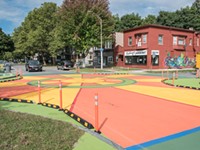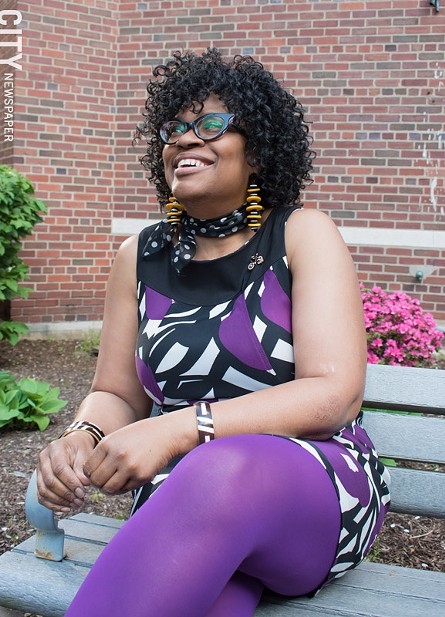
[
{
"name": "500x250 Ad",
"insertPoint": "5",
"component": "15667920",
"parentWrapperClass": "",
"requiredCountToDisplay": "1"
}
]
A decade ago, Rochester had hardly any bike lanes. Now it has more than 60 miles' worth.
The city completed its Bicycle Master Plan in 2011 and then began a prolonged effort to make its streets more bike friendly. It has experimented with cycle tracks, bike-only pathways that run parallel to roads but are physically separated from motor vehicle traffic; it's developed a series of bike boulevards, which route cyclists off of busy main roads and through lower-stress neighborhood streets; and it's brought in the Pace bike share program.
"We've made a lot of progress over the last five-plus years when it comes to bike facilities here in the city and giving people options: the tools by which they can choose their mode of transportation," says Erik Frisch, manager of special projects in the City of Rochester's engineering bureau. "Bicycling's become a big part of that."
But right now, the city's in its adolescence when it comes to cycling, and it's experiencing growing pains, says Scott MacRae, the founding president of the Rochester Cycling Alliance. Physically, the bike network is still developing and expanding. Mentally, public attitudes toward bikes on roads, and as a viable means of transportation, are still maturing.
The city installs several miles of new bike lanes or thoroughfares every year, but as that work continues, the network is disjointed in many places. Lanes can end suddenly, creating a situation where cyclists have to adjust to traffic. That's a skill that gets more intuitive with practice, but for a new cyclist the experience can be scary, if not dangerous. And the experience could deter riders from biking in the future.
It's also common to see cars, delivery vehicles, and even police vehicles parked in bike lanes, a problem brought to light in a recent report from CITY's news partner, WXXI. Over eight weeks of commuting to work and running errands by bike, reporter Brett Dahlberg recorded more than 200 cars parked in bike lanes.
Those obstacles force cyclists out of their lane and into motor vehicle traffic, which can be difficult even for the most experienced cyclist.
Cycling advocates want the city to be aggressive about enforcing violations; in Rochester it's not against the law to park or stand in a bike lane per se, but the lanes are generally in places where it's illegal to park for other reasons.
However, drivers parking in bike lanes embody a larger transportation culture clash. Many people prioritize motor vehicle traffic over cyclists and pedestrians, and some drivers can be downright hostile to cyclists.
Bicyclists have responsibilities of their own, and if they live up to them they may lessen the hostility they face from some drivers while biking safer.
Cycling advocates and planners says one of the most important things cyclists can do to stay safe is follow traffic laws, which means riding in the same direction as traffic and obeying traffic signals.
"We teach that the number one thing you can do on your bike to get into a collision with a car is riding against traffic on the left," says Jesse Peers, a bike educator certified through the League of American Bicyclists and the new cycling coordinator for Reconnect Rochester, a transportation advocacy group.
Every year the League of American Bicyclists, a national cycling advocacy group, evaluates cities across the country for their bike friendliness. It assigns rankings of diamond, platinum, gold, silver, and bronze based on what it calls the 5 E's: engineering, education, encouragement, enforcement, and evaluation and planning.
Portland, which is widely considered an exemplary city for bike friendliness, has a platinum ranking. The League gave Rochester a bronze ranking in 2012, and it remains at that position.
The city has focused heavily on designing and building bike infrastructure – the engineering part of the 5 E's – and cycling advocates have praised officials and staff for that work. But they've also pushed for officials to move faster on infrastructure and to add more lanes protected by bollards, planters, curbing, or some other barrier that would buffer riders from drivers.
City planners have been receptive to protected bike lanes, though Frisch says they aren't appropriate or possible along all roadways.
"We're looking at different ways that we can provide bike facilities that are separated from traffic," Frisch said. "So that's going to feel more comfortable for a cyclist riding in terms of not being next to moving cars, and it's also going to ensure that there are not parked cars on that bike lane, which will also help."
The city is safer for cyclists than it was five years ago, Justin Roj, the city's communications director, said during an early May interview alongside Frisch. "We'll be safer as time goes on, especially with some of our ongoing projects," which include additional painted lanes, some protected lanes, and ongoing traffic-calming work.
Much of the engineering work is not directed at experienced cyclists who are going to ride no matter what, nor is it directed at people who just won't get on a bike, Frisch says.
"We know that the majority of potential cyclists are in the 'interested but concerned' category," Frisch said. And serving that group is key to growing the share of people biking, he said.
The "interested but concerned" cyclists are also more likely to be deterred from biking, especially if they have particularly stressful trips or get clipped by drivers. Peers says education is an important component of making a community bike-friendly, because it helps build confident cyclists and considerate motorists.
"I think most of the work, actually, up front, is just breaking people's perceptions, because there's this perception out there that cycling is so dangerous, and it's really not," he says.
Peers didn't bike at all during his 20's, and he says he's not much of a risk-taker. But after Reconnect Rochester's Roc Transit Day in 2013, he began to realize that he could ditch his "beat-up Cavalier" and use other types of transportation for his mile-and-a-half commute to work.
To build up his road skills, he took a two-hour biking class at the Rochester Brainery, similar to the ones he now leads.He hasn't had a car for more than five years, and his health as well as his family's finances have improved, he says.
"That class not only gave me the confidence to get out and ride, but it seriously changed my life, and it changed the trajectory of what I was doing," says Peers.
Cycling advocates say there's a role for traffic law enforcement in building a bike-friendly communities. When drivers break the law and hit cyclists as a result, they should be ticketed. But the law is a two-way street, and police could also ticket every wrong-way cyclist.
Peers and other cycling advocates see education as far more proactive, effective, and worthwhile. In his classes, he teaches cyclists the rules they should follow, proper positioning within the road, and precautions for increasing their visibility.
He also reaches out to schools and offers to teach fifth- and sixth-grade classes about safe biking and the rules of the road. If children were taught those skills on a regular basis, there would be a double benefit, Peers says. They'd have a better grasp on traffic rules and safety practices while they're riding their bikes. And later, when they learn to drive, they'd also have an understanding of cyclists to the road, he says.
"Going for your driver's license should not be your first traffic education," Peers says.
Kecia McCullough began cycling five years ago, when she bought herself a bike for her 50th birthday. For the next two years, she'd load the bike onto her car's rack and drive to the Erie Canal pathway, where she rode exclusively. She was riding with friends and they were largely men.
But McCullough, who is black, started wondering where all the women were. And on the occasions when she did pass women biking, most of them were white. In July 2016, she started the Rochester chapter of Black Girls Do Bike as a way to encourage women – particularly women of color – to get on bicycles, McCullough says.
McCullough and Black Girls Do Bike have, in many ways, grown together. She now bikes from her home near the city's center to her office at the University of Rochester Medical Center, where she's a social worker with Strong Mental Health and Wellness. She also runs errands on her bike and rides to her granddaughter's house.
The first Black Girls Do Bike rides were held on bike paths, but many now happen on city streets. The rides have a relaxed pace and are meant to serve as a safe space for cyclists of all abilities and they emphasize safety. Participants do a safety check of their bikes before every ride, and leaders emphasize fundamental rules of the road such as keeping to the right, using hand signals, and riding in a way that is safe for both cyclists and drivers.
The whole idea of the group is for people to see cycling as a viable, healthy, and fun way of getting around, McCullough says. In other words, she's providing potential bicyclists with encouragement and education, which are essential for building a bike-friendly Rochester.
"I think people are feeling more confident, more empowered," McCullough says.
She appreciates the city's investment in infrastructure and thinks it's done a good job, though she wants to see the work continue. Some bike lanes aren't "seamless," she said, but the city is working to better the situation. She recently went on a tour where the city's Frisch guided folks through some of the new bike path and lane connections that will be part of the ROC the Riverway project.
But like other advocates, she believes that some drivers need to be more respectful of cyclists, including "being aware that cyclists are a vulnerable population and that we deserve to be on the road."
No one group is going to make Rochester a bike-friendly city. Advocates, city staff and elected leaders, state officials, drivers, and individuals are all going to have to play a part.
Cycling advocates across New York have called on state legislators to approve a safe-passing law, similar to laws on the books in other states. Pennsylvania requires drivers to leave a four-foot buffer while passing cyclists, for example. New York's law only requires drivers to leave "a safe distance" as they pass cyclists.
Local cycling, advocacy, and neighborhood groups have also encouraged the city to adopt a Vision Zero policy and plan. Vision Zero is a concept that originated in Sweden, and it centers on a goal of eliminating all traffic deaths.
The approach assumes that people will make mistakes on the road, and it emphasizes creating a road system that minimizes the severity of collisions. It involves detailed, collaborative planning as well as road design and speed-control efforts.
But there are simpler ways to encourage biking. At a government level, the League of American Bicyclists suggests bike sharing and route-finding signage, both of which the City of Rochester has done.
The local cycling community wrapped up Rochester Bike Week on May 19, after more than seven days of group rides, socials, and other events. The city partnered with bike groups for several of the events, including the annual Ride of Silence, which honors cyclists killed or injured while biking on public roadways. The ride is also intended to reinforce that cyclists and cars share the road.
Still, Peers and MacRae say they'd like to see more happen on the encouragement end of things. City Hall could work with community and health care organizations on a campaign to get people on bikes for the first time, Peers says. MacRae wants the city to establish a bike-pedestrian advisory committee.
Peers and MacRae also say they'd like to see more city officials out biking the streets. Officials would be able to make more informed decisions on infrastructure, and they'd set an example for the rest of the community, they say.
Mayor Lovely Warren will be biking with some novice Black Girls Do Bike members on the canal path as part of a closed ride for the organization's third anniversary, McCullough says.
"I want to introduce people to cycling and not have it be threatening or overwhelming," McCullough says.
City Council member Mitch Gruber, who recently became chair of Council's Parks and Public Works Committee, says that Rochester has a "robust" complete-streets policy, and that the administration has done a good job incorporating it into projects. Gruber wants to start working with the administration's complete-streets team, as well as advocacy groups, to strengthen that work, he says. The community also needs to look beyond infrastructure, he says.
"I want to find all the right ways that a city can create a culture of biking and active transportation for everyone, but I also want to be mindful that culture changes are something that needs to come both from the government and from the community," Gruber says. "It needs to be top down and bottom up."
Cities across the country are working to become more bike-friendly and Rochester competes with many of them for workers, employers, and students. Rochester officials and transportation advocates agreed years ago that Rochester would be a better place if it was bike-friendly, and they've all put in a lot of work to that end.
But to encourage everyday cycling in Rochester, more people will have to see it as a safe, enjoyable, freeing, and viable transportation option. And for that to happen, street designs will have to change, as will people's habits and attitudes.
"If Rochester and the metropolitan region want to retain and attract people, this cannot be an oppressive, hostile environment for people without cars," Peers says.
This piece includes reporting by Brett Dahlberg at CITY's partner WXXI News.
Speaking of...
-

Beechwood's bump in the road
Sep 19, 2018 -

Bike sharing heads toward a summer start
May 10, 2017 - More »






